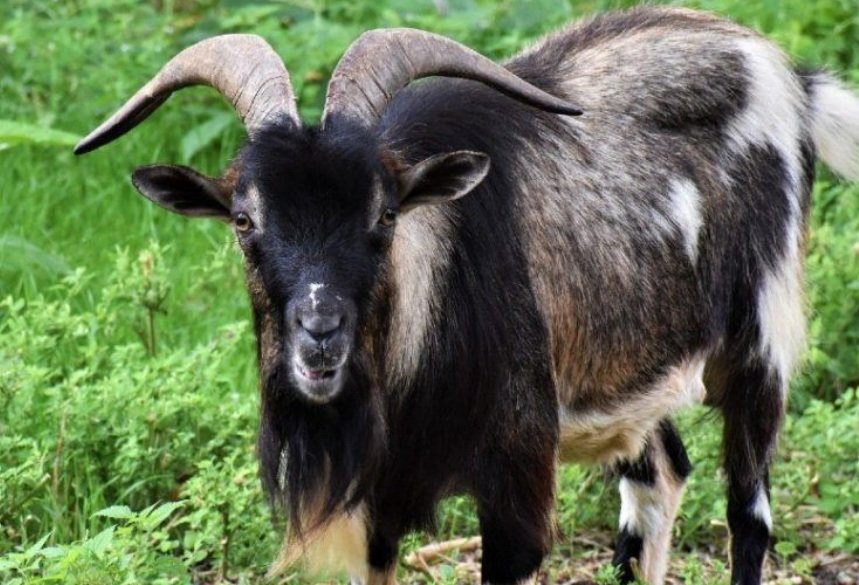
Spanish Goat Breed: Resilience and Adaptation for Grazing
The Spanish goat breed is renowned for its resilience and climatic adaptation. They range in size from medium to giant, and both the males and females have horns. Because of their superior foraging skills, these goats are ideal for grazing in a variety of habitats. Spanish goats are a popular option for meat production because of their lean, tasty flesh, which is also highly prized.
Distinct Color Patterns: Aesthetic Appeal and Maternal Instincts
The distinct color patterns of Spanish goats are an intriguing feature. They may have coats that are speckled or mottled, in addition to hues like black, brown, and white. Their visually appealing color variety enhances their overall attractiveness. Spanish goats are also renowned for having strong maternal instincts, which makes them wonderful caregivers who give their young their full attention and devotion.
High Reproductive Rates: Desirable Traits for Breeding
The high reproductive rates of Spanish goats are another noteworthy feature. They are renowned for having an easy time reproducing and giving birth to many children at once. Because of this, they are a desirable breed for anyone who wants to start breeding programs or grow their herd. All things considered, Spanish goats are a hardy and adaptable breed with a lot to offer in terms of meat yield, flexibility, and general hardiness.

Historical Significance and Heritage
History and Origin: Spanish Goat Introduction to the Americas
Spanish explorers and colonists introduced the Spanish goat breed, commonly referred to as the brush goat or scrub goat, to the Americas. These goats were hardy and adaptive because they were well-suited to rural Spain’s rough landscape and severe weather.
Spanish goats became assimilated into the American agricultural and cultural environment. They were prized for their toughness, capacity to find food in difficult conditions, and ability to produce meat and milk.
Anatomy: Unique Physique and Climbing Abilities
Spanish goats have a small build and a well-muscled physique for their size. Their coats come in a variety of colors and designs, such as solids, spots, and patches. Their characteristic long, twisted horns enhance their unusual look.
Spanish goats are known for their exceptional athleticism and agility. They are skilled climbers, so they can easily negotiate rough and steep terrain. They can search for food in places where other animals would find it difficult because of their powerful hooves, which provide them stability.
Flexibility and Sturdiness: Adaptability to Various Environments
Spanish goats are renowned for their toughness and flexibility. They are remarkably adaptable to a wide range of environments, including hilly areas, lush woods, and parched deserts. Their genetic make-up and decades of natural selection have produced this versatility.
These goats are less prone to typical goat illnesses because they have a robust immune system and disease tolerance. They are renowned to be exceptional foragers, finding food even in areas with little vegetation, and they can tolerate very high or low temperatures.
Uses and Versatility
Spanish goats have long been prized for their adaptability and variety of applications. Their meat, which is prized for its taste and softness, is the main reason they were raised. Many chefs and customers like the lean flesh of Spanish goats.
Milk and meat production
Spanish goats are employed not only for meat production but also for milk production. Their high butterfat content makes their milk perfect for creating cheese and soap, even if they don’t produce as much milk as some other goat breeds.
Helps to clear farms
Moreover, Spanish goats are often used for clearing land and managing vegetation. Their browsing habits reduce the risk of wildfires and aid in the management of exotic plant species. These goats are a common, environmentally acceptable substitute for chemical pesticides among farmers and landowners.

Environmental Initiatives
Spanish goats are now the target of conservation efforts to maintain their distinctive genetic features because of their historical and cultural importance. To preserve the breed’s integrity and stop crossbreeding with other goat breeds, a number of organizations and breeders are engaged in this endeavor.
The goals of conservation initiatives are to preserve the genetic variety of Spanish goats and guarantee their continued existence for future generations. These initiatives help to preserve this exceptional breed by encouraging ethical breeding methods and informing the public about its significance.
The Legacy of Spanish Goats
The breed of Spanish goats is a living example of hardiness, flexibility, and adaptation. They are a fascinating topic of study and adoration because of their distinctive qualities and historical relevance. Spanish goats continue to enthrall and contribute to numerous sectors and conservation efforts because of their physical characteristics, adaptability to harsh settings, and versatility.


